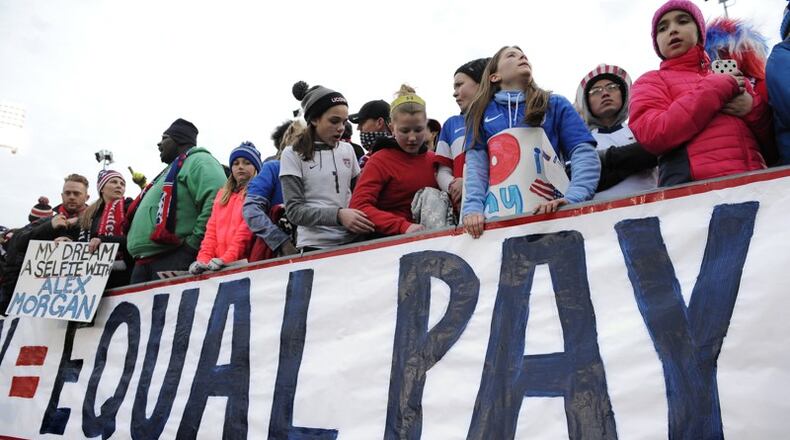In the last decade, women’s wage gap in Ohio and the U.S. has hovered around 77 cents for every dollar men make, according to data from the U.S. Department of Labor Statistics. The amount of money can differ depending on the woman’s field of work and her race, according to a new data study from LiveStories, a civic data hub.
“The legal industry in Ohio is among the worst when it comes to equal pay — women are only earning 70 cents for every dollar men earn. The analysis reveals that median earnings for legal positions in Ohio increased by more than $10,000 for men, while the pay for women increased by less than half that rate — from $53,615 in 2006-2010 to $57,144 in 2011-2015,” according to the report.
» RELATED: Workplace incivility, aggression impacts more than half of US workers
In the third quarter of 2017, the average weekly earnings for men was about $937 while women made $767 on average. That differed even more based on race. Asian men had the highest average weekly earnings at $1,147 while white men made $965. Hispanic or Latina women made an average weekly wage of $597 while black women made $658. White women made $791.
“The wage gap is not even equal among women,” said Lisa Borello, University of Dayton Women’s Center director.
Women and men working full time in management, business, and financial operations occupations had higher median weekly earnings than workers in any other major occupational category in 2016 ($1,099 for women and $1,491 for men). Within management, business, and financial operations occupations, women who were chief executives ($1,876) and computer and information systems managers ($1,680) had the highest median weekly earnings in 2016, according to the Bureau of Labor Statistics.
“On average, women continue to earn considerably less than men, a statistic that cuts across occupations and geographies. The wage gap for women of color is even worse – and has barely changed in the past century,” said Audrey Starr of YWCA Dayton. “We have to do better. We have to center the conversation around where gender discrimination, racial injustice, systemic biases, and outdated policies meet.”
Gender pay gap is an issue that matters to women and their families across the U.S. On average, women employed full time in the United States lose a combined total of more than $840 billion every year due to the wage gap. The wage gap persists even though women are attaining degrees at higher rates than their male counterparts.
» RELATED: Colleges, employers want female engineers: Where are they?
And for the first time, more women than men are better educated than their spouse, according to research from the Institute for Family Studies. About 25 percent of husbands are married to wives who are more educated than them, but they’re still making more money than their wives.
“Regardless of how men’s education compares to their wives, husbands still end up having an edge on earnings,” writes Wendy Wang, director of research at the IFS.
Borello said UD and other colleges prepare female students to negotiate for more through the AAUW Start Smart salary negotiation workshops. The workshops help students identify and articulate their personal value; develop an arsenal of persuasive responses and other strategies to use when negotiating; and learn about the wage gap and its long-term consequences.
“You have to prepare young people for the realities they face once they leave a college campus,” she said.
She encouraged women to research comparable salaries in their field and articulate their value to potential employers. Borello said because social norms discourage people from talking about their salaries, it further perpetuates the gender wage gap for many women.
» RELATED: Opioid crisis compounds rising domestic violence cases
Julene Allen, founder of Lean In Ohio and executive director of nonprofit Women for Action, is educating local businesses about the gender pay gap. The Lean In Ohio Chapter provides education, peer support and resources for women who are aiming for the next level.
She said Lean In Ohio is constantly discussing action to take on gender wage gap issues, and said she encourages women to push local legislators into supporting policies that encourage pay transparency within companies. Reporting and having access to pay data is another step toward pay equality, she said.
Her advice to women wanting equal pay? “I would tell her to look into how to negotiate her pay or to ask for a higher salary,” she said. “Have an uncomfortable conversation with her employer. I would encourage her to support legislators who are fighting for and promoting equal pay.”
BY THE NUMBERS
• 6 in 10 women identified equal pay as one of the most important issues facing women in the workplace
• 44 years: How long it would take the U.S. to break the gender wage gap
• Only 28 percent of women are confident they are paid the same salaries as their male counterparts
Source: National Partnership for Women & Families, leanin.org
FIVE FAST BUSINESS READS
• 7 major data hacks that happened in 2017
• Why is Buffalo Wild Wings nicknamed BW3s?
• Overheard while Thanksgiving shopping: 'Your dad is going to kill me'
• 5 ways to stay out of debt this holiday shopping season
• 17 retail horror stories that show working Black Friday is the worst
About the Author
